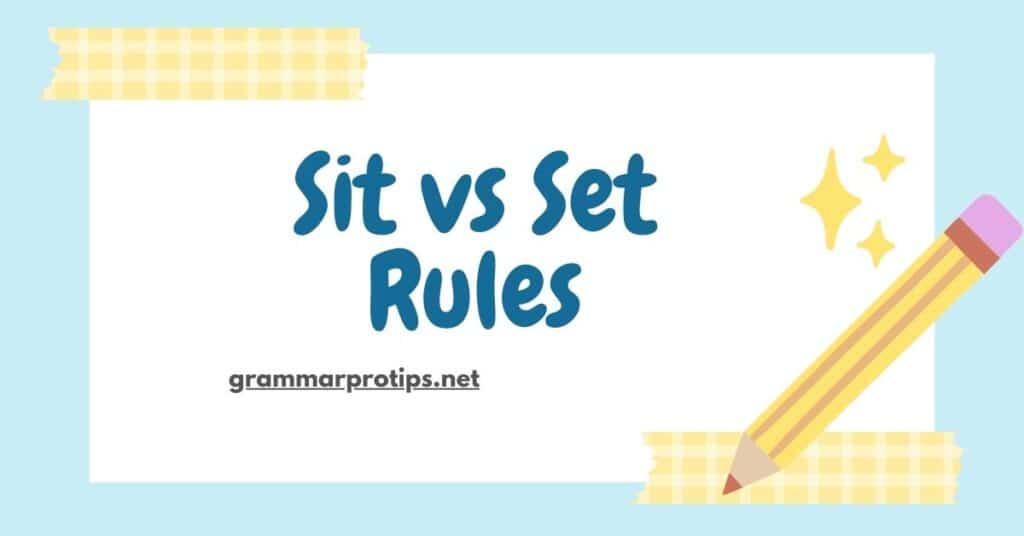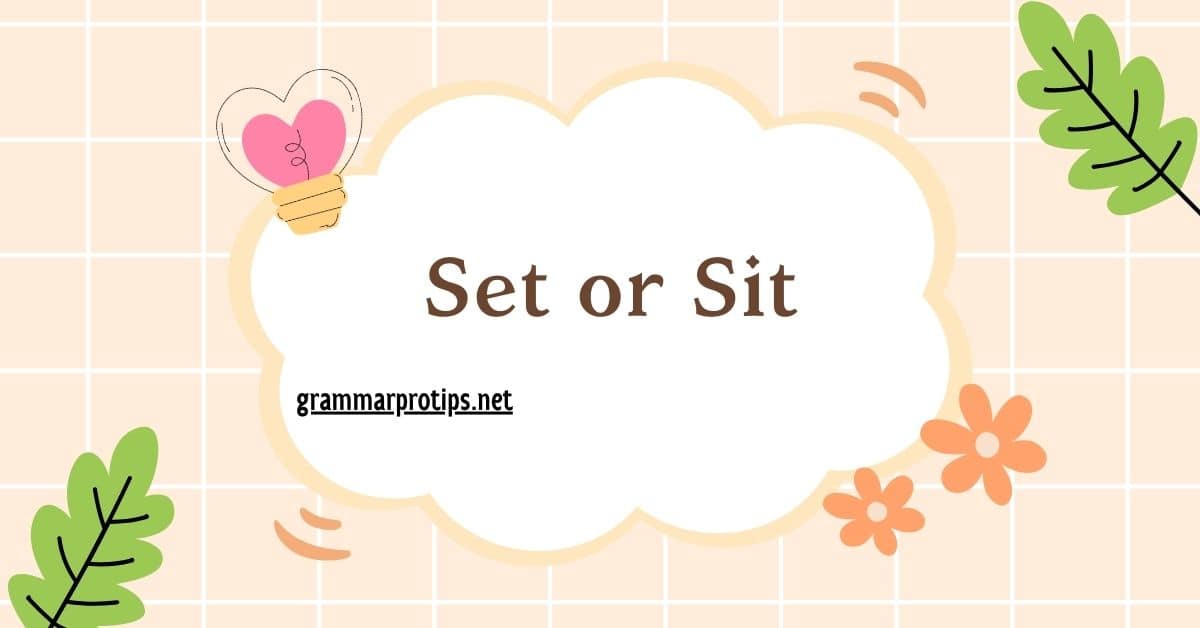The English language, with its nuances and intricate rules, often confuses even the most seasoned speakers. Two commonly mixed-up verbs are “set” and “sit”. While they may seem interchangeable in certain contexts, understanding when and how to use each correctly can elevate your command of English.
In this article, we’ll dive deep into sit vs set explaining the differences, usage rules, and providing sit vs set examples to clarify any confusion.
Understanding Sit vs Set: The Basics
Before we jump into specific scenarios, it’s important to establish the basic difference between sit and set.
- Sit is an intransitive verb, which means it doesn’t require a direct object. It refers to the act of being in a seated position. Example: “I sit at my desk every morning.”
- Set is a transitive verb, meaning it requires a direct object. It refers to placing something down intentionally in a particular position. Example: “She set the book on the table.”
By grasping this fundamental distinction, we can explore how these verbs work in different situations.
Sit vs Set: When to Use “Sit”
To sit means to place yourself in a seated position. It doesn’t take an object because it refers to the action you’re performing on yourself. You can also use sit in its various forms like sitting, sat, and sits, depending on the tense.
Example 1: In an Email
Scenario: You’re writing an email to a colleague about a meeting.
Subject: Meeting Update – Let’s Sit Down for Discussion
Hi [John],
I hope you’re doing well. I wanted to check if you’re available for a quick meeting tomorrow morning. Would you like to sit and discuss the project? I think we could resolve a lot of things by just sitting down together.
Let me know what works best for you.
Best regards,
[Your Name]
In this case, sit refers to the action of physically positioning yourself in a chair for a discussion.
Example 2: At Home
Imagine you’re inviting a friend over for dinner.
“Sit down and relax; dinner will be ready soon.”
Here, you’re inviting someone to take a seat and relax, using sit in its simplest form.
Sit vs Set: When to Use “Set”
On the other hand, set involves intentionally placing or arranging something in a specific spot. This verb requires a direct object, which is the item being placed.
Example 1: In an Email
Scenario: You’re reminding a team member to prepare for an important presentation.
Subject: Prepare the Materials
Hi [Anna],
Just a quick reminder to set the projector in place before the meeting. Ensure everything is aligned, and the slides are ready to go. We can test it once it’s set up.
Thanks,
[Your Name]
Here, set refers to the action of putting something (the projector) into position.
Example 2: At Home
Imagine you’re setting the dinner table.
“Please set the plates on the table for our guests.”
In this example, set refers to the action of placing the plates deliberately on the table.
Setting vs Sitting: What’s the Difference?
The difference between setting and sitting can be subtle but crucial, depending on the context. While both are gerund forms of their respective verbs, the meaning changes.
- Setting refers to the act of placing something or arranging it.
- Sitting refers to the act of being seated or positioning oneself in a sitting posture.
Example:
- “I’m setting the books on the shelf” (Placing books).
- “I’m sitting on the couch” (Being seated).
Let’s take a closer look at setting vs sitting in action.
Example 1: Setting up a meeting space. “Before the presentation, make sure you’re setting up the chairs.”
Example 2: Sitting down at your desk. “I’m sitting at my desk, ready to start the project.”
Sit vs Set Rules: How to Remember

It’s easy to get confused between sit vs set, but there are a few simple rules that can help you remember when to use each verb.
- Sit is for actions where you’re placing yourself in a seated position or remain in that position.
- Set involves an action where you place or arrange something else, with a clear object receiving the action.
Sit or Set: Here’s a simple rule of thumb:
- If you’re talking about yourself, sit is the verb.
- If you’re talking about an object, set is the verb.
Sit vs Set Pronunciation: A Subtle Distinction
Though sit and set are both short, simple words, they differ in pronunciation. The vowel sounds are what distinguish them.
- Sit has a short “i” sound, like in “hit” or “bit.”
- Set has a short “e” sound, like in “bet” or “let.”
The distinction is subtle but important, especially in conversations where you’re trying to convey the correct action.
Sit vs Set Examples: Applying the Rules
Here’s a quick breakdown of sit vs set in various contexts:
| Context | Sit | Set |
|---|---|---|
| At a table | “She sits at the head of the table.” | “He sets the table for dinner.” |
| At a desk | “I sit at my desk for hours.” | “I set my coffee mug on the desk.” |
| Moving an object | “The dog sits by the door.” | “I set the box down in the corner.” |
| In a conversation | “Let’s sit and chat for a while.” | “She set the agenda for our discussion.” |
| Before an event | “We’ll sit and wait for the concert to start.” | “The chairs are set up for the event.” |
Sit vs Set Grammar: Common Mistakes to Avoid
Even experienced writers can sometimes make mistakes when using sit vs set. Here are some common errors:
- Mistake: “I set down on the chair.”
Correction: “I sat down on the chair.”
Explanation: The action of placing yourself down is sitting, not setting. - Mistake: “Please sit the books on the table.”
Correction: “Please set the books on the table.”
Explanation: You set an object, not yourself.
Sit vs Set Worksheet: Practice Makes Perfect
It’s always helpful to put the rules into practice. Here’s a quick sit vs set worksheet you can use to solidify your understanding:
- Fill in the blank with sit or set:
- He always _______ on the couch after work.
- I need to _______ the alarm for 7 a.m.
- She _______ the cup on the table carefully.
- They decided to _______ outside for lunch.
- Choose the correct form:
- I __________ (sit/set) the bag down gently.
- You __________ (sit/set) at the head of the table.
- Correct the sentences where necessary:
- “I will set on the couch after dinner.”
- “They are sitting the chairs up in rows for the event.”
Sit vs Set Quiz: Test Your Knowledge
Are you confident in your understanding of sit vs set rules? Here’s a quiz to test your knowledge!
- Which sentence is correct?
- A. I will sit the documents on your desk.
- B. I will set the documents on your desk.
- Choose the right verb:
- He ________ at the window, watching the rain.
- True or False: “I will sit the table for dinner” is correct grammar.
Answer Key:
- B. I will set the documents on your desk.
- sat
- False. The correct phrasing is, “I will set the table for dinner.”
Is an Object Sitting or Setting?
When dealing with inanimate objects, it can be tricky to decide whether to use sit or set. An object can sit in a position if it stays there without any movement (such as a book on a table), but it can also set in place when someone intentionally places it there.
Example: The book sits on the shelf.
The book was set on the shelf yesterday.
Conclusion: Mastering Sit vs Set in Everyday Language
Whether you’re writing an email, crafting a letter, or simply engaging in conversation, using sit vs set correctly can help you sound more polished and natural. Understanding the distinction between these two verbs for your own seated action and set for placing objects—will take your grammar to the next level. Keep practicing with sit vs set exercises, and soon it will feel second nature.
Remember: Sit is about positioning yourself; Set is about positioning something else.

Sienna Mauldon is a passionate writer and grammar expert. On her blog, she shares easy-to-follow guides to help readers master grammar rules and improve their writing. With a love for language and teaching, Sienna makes grammar simple and fun for everyone, from beginners to experienced writers.








